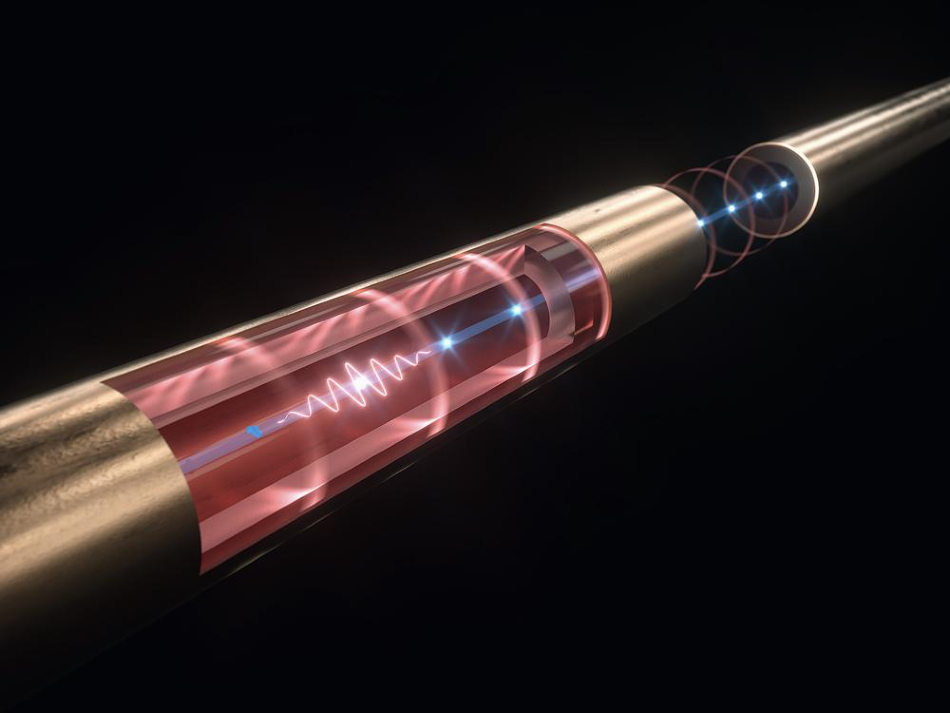Mar 23 2020
A tiny double particle accelerator developed by researchers from Deutsches Elektronen-Synchrotron (DESY) can recycle some part of the laser energy introduced into the system to increase the energy of the accelerated electrons a second time.
 The mini-accelerator uses terahertz radiation that can be recycled for a second stage of acceleration. Image Credit: DESY, Science Communication Lab.
The mini-accelerator uses terahertz radiation that can be recycled for a second stage of acceleration. Image Credit: DESY, Science Communication Lab.
Narrowband terahertz radiation is typically used by the novel device and this radiation lies between radio and infrared frequencies in the electromagnetic spectrum, with a single accelerating tube measuring only 0.79 mm in diameter and 1.5 cm in length.
Dongfang Zhang and his collaborators from the Center for Free-Electron Laser Science (CFEL) at DESY have described their experimental particle accelerator in the Physical Review X journal.
The short wavelength of terahertz radiation was responsible for the miniature size of the device.
Terahertz-based accelerators have emerged as promising candidates for next-generation compact electron sources.
Franz Kärtner, Lead Scientist, Deutsches Elektronen-Synchrotron
Kärtner is also the head of the CFEL team that developed the novel device.
Earlier, terahertz accelerators had been effectively tested by researchers. Such accelerators could lead to applications, where large particle accelerators are simply not essential or viable.
“However, the technique is still in an early stage, and the performance of experimental terahertz accelerators has been limited by the relatively short section of interaction between the terahertz pulse and the electrons,” added Kärtner.
For the latest device, the researchers utilized a longer pulse containing several cycles of terahertz waves. The interaction section with the particles is considerably extended by this multicycle pulse.
“We feed the multicycle terahertz pulse into a waveguide that is lined with a dielectric material,” stated Zhang. The pulse’s speed is decreased within the waveguide. A group of electrons is directed toward the central portion of the waveguide just in time to move along with the pulse.
This scheme increases the interaction region between the terahertz pulse and the electron bunch to the centimetre range—compared to a few millimetres in earlier experiments.
Dongfang Zhang, Center for Free-Electron Laser Science, Deutsches Elektronen-Synchrotron
While the novel device did not create a massive acceleration in the laboratory, the researchers can potentially demonstrate the concept by showing how electrons are able to acquire energy in the waveguide.
“It is a proof of concept. The electrons’ energy increased from 55 to about 56.5-kilo electron volts,” added Zhang. “A stronger acceleration can be achieved by using a stronger laser to generate the terahertz pulses.”
The arrangement is primarily developed for the non-relativistic regime, implying that the speed of the electrons is not very close to the speed of light. Fascinatingly, the non-relativistic regime facilitates the recycling of the terahertz pulse for the second stage of acceleration.
“Once the terahertz pulse leaves the waveguide and enters the vacuum, its speed is reset to the speed of light,” added Zhang. “This means, the pulse overtakes the slower electron bunch in a couple of centimetres. We placed a second waveguide at just the right distance that the electrons enter it together with the terahertz pulse which is again slowed down by the waveguide. In this way, we generate a second interaction section, boosting the electrons’ energies further.”
Just a small amount of the terahertz pulse could be recycled in this manner in the laboratory experiment. However, the experiment revealed that recycling is possible theoretically, and Zhang believes that the recycled fraction can be considerably boosted.
Our cascading scheme will greatly lower the demand on the required laser system for electron acceleration in the non-relativistic regime, opening new possibilities for the design of terahertz-based accelerators.
Nicholas Matlis, Team Leader and Senior Scientist, Center for Free-Electron Laser Science, Deutsches Elektronen-Synchrotron
The study was financially supported by the EU Synergy Grant AXSIS (frontiers in Attosecond X-ray Science: Imaging and Spectroscopy) at CFEL. CFEL is a joint venture of the Max Planck Society, DESY, and the University of Hamburg.